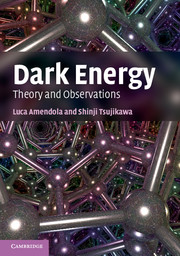Book contents
- Frontmatter
- Contents
- Preface
- List of Frequently used symbols
- 1 Overview
- 2 Expansion history of the Universe
- 3 Correlation function and power spectrum
- 4 Basics of cosmological perturbation theory
- 5 Observational evidence of dark energy
- 6 Cosmological constant
- 7 Dark energy as a modified form of matter I: Quintessence
- 8 Dark energy as a modified form of matter II
- 9 Dark energy as a modification of gravity
- 10 Cosmic acceleration without dark energy
- 11 Dark energy and linear cosmological perturbations
- 12 Non-linear cosmological perturbations
- 13 Statistical methods in cosmology
- 14 Future observational constraints on the nature of dark energy
- 15 Conclusion and outlook
- 16 Answers to the problems
- 17 Mathematical Appendix
- References
- Index
12 - Non-linear cosmological perturbations
Published online by Cambridge University Press: 05 March 2013
- Frontmatter
- Contents
- Preface
- List of Frequently used symbols
- 1 Overview
- 2 Expansion history of the Universe
- 3 Correlation function and power spectrum
- 4 Basics of cosmological perturbation theory
- 5 Observational evidence of dark energy
- 6 Cosmological constant
- 7 Dark energy as a modified form of matter I: Quintessence
- 8 Dark energy as a modified form of matter II
- 9 Dark energy as a modification of gravity
- 10 Cosmic acceleration without dark energy
- 11 Dark energy and linear cosmological perturbations
- 12 Non-linear cosmological perturbations
- 13 Statistical methods in cosmology
- 14 Future observational constraints on the nature of dark energy
- 15 Conclusion and outlook
- 16 Answers to the problems
- 17 Mathematical Appendix
- References
- Index
Summary
Cosmology is, by and large, the realm of linear gravitational processes. When gravitational instability reaches a regime of non-linearity, astrophysical objects form (galaxies, black hole, stars) and the memory of the global structure of spacetime, and therefore of cosmology, is lost or diluted in new physics and new interactions. There is however an intermediate regime in which gravity is still the only player but effects beyond linearity begin to be observable. This regime lies between the linear perturbation theory we have explored in the previous chapter and the full nonlinear dynamics that can be dealt with only in N-body simulations or by focusing on single objects.
It may be expected that the presence of dark energy will not influence small-scale non-linear processes. This is probably true for standard dark energy, i.e. a smooth component with negligible clustering described by a slowly varying equation of state. However we have learned how rich the possible phenomenology of dark energy is. We cannot exclude that weakly non-linear processes might keep some record on the cosmological conditions in which they developed. We know of at least one such process, the epoch of the beginning of structure formation and, as a consequence, the abundance of collapsed objects.
This chapterwill present the effects of non-linearity in higher-order cosmological perturbation theory that are of interest in dark energy research. Primes here denote differentiation with respect to N = ln a.
- Type
- Chapter
- Information
- Dark EnergyTheory and Observations, pp. 336 - 355Publisher: Cambridge University PressPrint publication year: 2010



